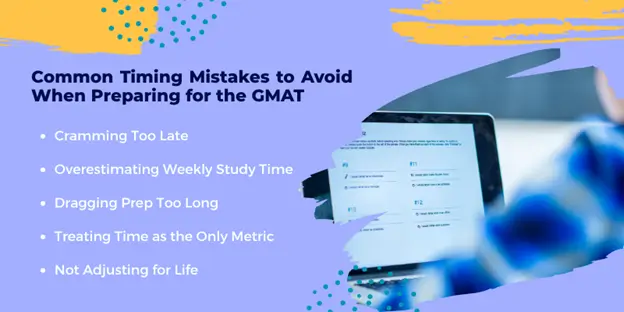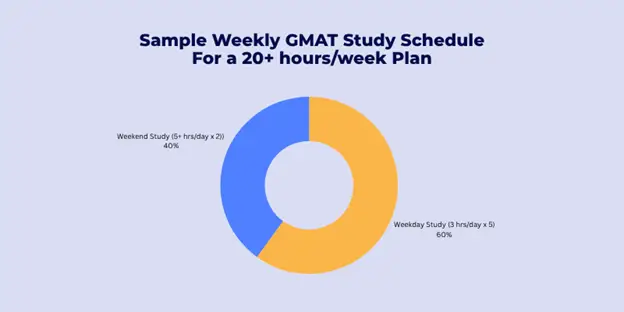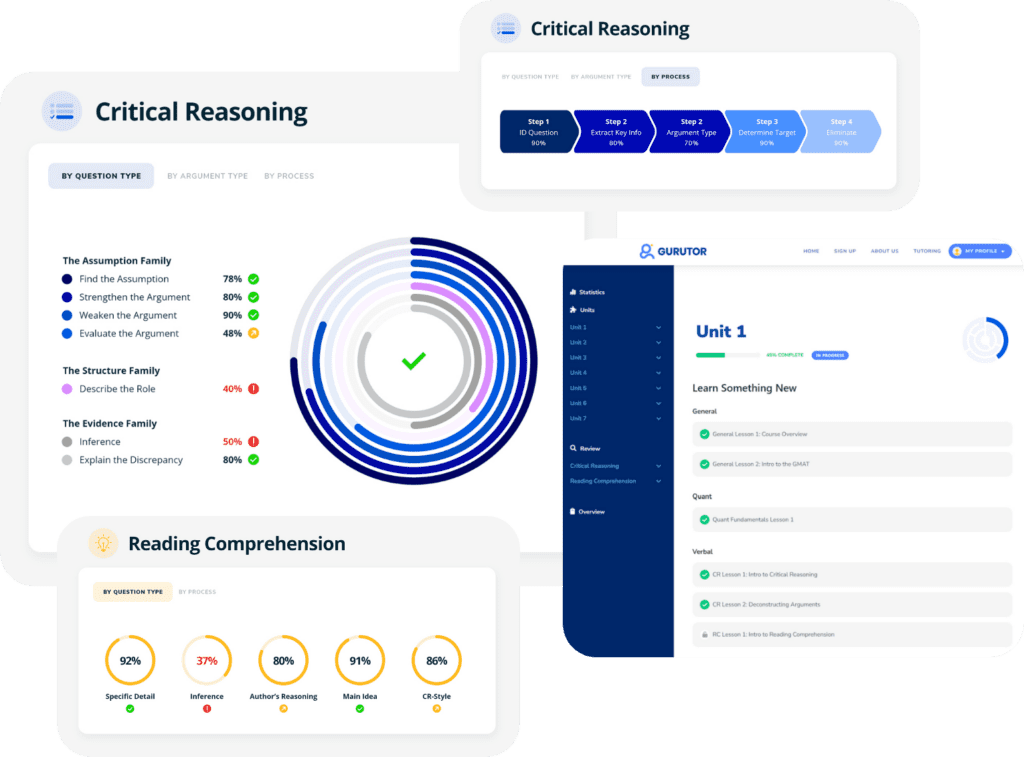How Long Does it Take to Prepare for the GMAT?

Preparing for the GMAT is a major step in your business school journey.
And one of the very first questions you’ll likely ask yourself is: how long does it take to prepare for the GMAT?
The short answer? It depends. The better answer: it depends on how you study, not just how much.
There’s no universal timeline that works for everyone, as a few key factors shape your ideal GMAT prep duration: your current skill level, your target GMAT score, the amount of time you can realistically dedicate each week, and the efficiency of your study methods.
For some students, a focused 8-week plan may be enough. For others, especially those balancing full-time work or starting from a lower baseline, 3 to 6 months of consistent study may be more appropriate.
The good news is that with the right strategy, you can optimize your timeline, no matter how much time you have.
In this comprehensive guide, we’ll walk you through:
- Why Prep Time Matters for GMAT Success
- GMAT Study Time Estimates by Target Score
- Factors that Affect GMAT Study Time
- Weekly Study Time Examples
- How to Create Your Personalized GMAT Study Timeline
- How to Prep Smarter with a Time-Efficient System
Whether you’re starting from scratch or retaking the exam, this guide will help you understand how long GMAT prep should take for you, and how to make every hour count.
Why Prep Time Matters for GMAT Success
Rushing through your preparation or mismanaging your study schedule can lead to disappointment on test day.
On the other hand, well-planned and adequate GMAT preparation time is strongly linked to better performance.
Most GMAT students put in serious hours. According to mba.com, the median prep time across all test-takers is about 80 hours.
However, higher scorers go well beyond that, studying for 2 to 3 months, and those aiming for top scores often push past 170 hours, sometimes stretching their preparation over 6 months or more.
The takeaway? Time matters. But it’s not just how much you study, it’s how you use that time in a structured way.

Here are the most common timing mistakes to avoid:
- Cramming Too Late
Many students underestimate the GMAT Focus Edition and start too close to their test date.
Last-minute prep rarely works. Start early, as soon as you know you’ll need a score. Also, GMAT scores are valid for 5 years.
- Overestimating Weekly Study Time
Planning for 20+ hours/week sounds good, but life happens. While 65% of students plan to do so, only 5% actually achieve it. If you have a full-time job, aim for 10–14 hours/week.
- Dragging Prep Too Long
Studying “on and off” for 9–12 months kills momentum. A focused 2–4 month prep is more effective than a year of re-learning what you forgot.
- Treating Time as the Only Metric
300 hours won’t mean much if you’re repeating mistakes. What matters is whether those hours are correcting what’s broken and building what’s missing. Focus on quality: correct your mistakes, fix your weak spots, and use every hour strategically.
- Not Adjusting for Life
Unexpected life events will happen. Build in buffer time and be ready to recalibrate instead of quitting when things go off track.
To avoid these common mistakes: start early, study smart, stay realistic, and adapt when needed.
GMAT Study Time Estimates by Target Score
How many hours to study for GMAT? It depends on your score goal and the Focus Edition’s shifted percentiles.
Here are three brackets with percentile ranges and time estimates:
545–595: Basic Coverage (~100–150 hours)
This range is suitable for test-takers seeking to build a strong score, typically aligning with the 30th to 50th percentile on the Focus Edition.
To study for this score bracket, allocate around 8-10 weeks, with 10-12 hours per week, emphasizing concept learning, and take 1-2 practice tests to assess early strengths and weaknesses.
For this score bracket, the focus area must be:
- Quantitative Reasoning: Build core arithmetic, algebra, and problem-solving skills.
- Verbal Reasoning: Improve grammar, reading comprehension, and logical reasoning.
- Data Insights: Understand charts, tables, and multi-source reasoning questions.
645–685: Competitive Mastery (~200–250 hours)
This score bracket reflects the new benchmark for competitive MBA admissions. On the GMAT Focus Edition scale, a score of 645 corresponds to the old 700 benchmark. This places you in the 88th – 89th percentile as of mid‑2025. That places it firmly in the competitive range for many top-tier programs.
To achieve this score, spread your prep over 12-14 weeks, with 15-20 hours/week. Use adaptive test platforms, focus on weak areas, and refine the strategy to attempt questions across all three areas.
So, if you’re a first-timer or a retaker, you must focus on the following areas:
- Quantitative Reasoning: Practice pacing, data sufficiency, and advanced problem-solving.
- Verbal Reasoning: Develop critical reasoning and accuracy in reading comprehension.
- Data Insights: Focus on skills in interpreting visual data and integrating information.
715+: Advanced Prep (~300+ hours)
A 715+ on the GMAT Focus Edition places you in the top 10% or higher, ideal for applicants aiming for top-tier business schools with highly competitive cohorts.
To reach this score, you’ll need 16–20 weeks of consistent prep and a system that actually teaches you, not just tests you. That means regular full-length practice exams to build stamina, targeted review of weak spots, and a study plan that evolves as you improve.
For example, with a self-paced platform like Gurutor, you don’t need a private GMAT tutor or expensive live GMAT coaching classes. The system gives step-by-step guidance while you study, correcting your work in real time and keeping you on track as you go.
Also, you must focus on the following areas:
- Quantitative Reasoning: Maximize accuracy under time pressure, master hard DS questions.
- Verbal Reasoning: Eliminate subtle traps in critical reasoning and tone-based RC questions.
- Data Insights: Achieve precision in multi-step integrated reasoning tasks.
Factors That Affect GMAT Study Time
There’s no one-size-fits-all number of hours for GMAT prep.
Two people might study the same amount of time and score very differently. That’s because your starting point, weekly availability, and study method all impact the number of hours you’ll need to complete.
Here’s a breakdown of each factor:
Starting Point and Skill Gaps
Your baseline score and the size of your skill gaps will heavily influence how long your GMAT prep takes. The lower your starting point or the wider the gap between Quant and Verbal, the more time you’ll need.
Here are some key considerations:
- Diagnostic score matters: Someone starting at 500 will need more hours than someone starting at 650 if both aim for a 700.
- General rule: An average of 20 hours of study for every 10-point increase if you’re using books or self-study methods.
- Low baseline = ramp-up time: Scores below the 40th percentile in Quant or Verbal may require weeks just to build foundational skills.
- Section imbalance: If you’re strong in Quant but weak in Verbal (or vice versa), you’ll need to spend extra time on the weaker section.
- Past experience helps: Familiarity with standardized tests (e.g., GRE, SAT) can reduce prep time. If you’re out of practice, expect a slower ramp-up.
Pro tip: Take a full-length, timed diagnostic GMAT as your first step. Your score gap (target score – diagnostic score) helps estimate total hours.
Work or School Commitments
Your weekly availability is just as important as the total number of hours.
How many hours can you realistically study per week, given your job, school, or family life?
Here are some of the most typical scenarios:
- Full-time professionals: Often manage only 10–14 hours/week. That means 200 hours of prep might take 4–5 months.
- Full-time students or between jobs: Can often do 20–30 hours/week, finishing a 200-hour plan in just 8–10 weeks.
- Students with light schedules: Should take advantage of free time before a demanding job starts. It’s easier to study while still in “school mode.”
Apart from these commitments, consider any project or family emergencies that might disrupt your schedule. Also, avoid big trips, events, or anything that breaks your routine.
Study Methods (Tutoring, Self-Paced, AI-Powered)
Not all study hours are created equal.
How you study has a major impact on how efficient your prep is. Some methods may cut down your required time dramatically.
Here’s a study method comparison chart:
| Method | Time Efficiency | Personalization | Cost Level | Flexibility | Common Pitfalls |
| Private Tutoring | Very efficient, and often requires the fewest hours to improve. | High, lessons are tailored to your exact needs. | Costly, and hourly rates can add up quickly. | Low, as tied to tutor availability and fixed sessions. | Hard to maintain consistently; not scalable for long prep timelines. |
| Study Groups | Varies; it can be productive or a time sink. | Low, as group learning rarely targets individual weaknesses. | Low, usually free or low-cost. | Medium, as it depends on group scheduling. | Can lack structure or drift off-topic; learning pace may not match your needs. |
| Structured Online Courses | Moderately efficient, better than books, but still general. | Medium, as a fixed curriculum, may not adapt to your strengths/weaknesses. | Moderate, requires a one-time or subscription fee. | High, study on your own time, but often rigid modules. | May spend time on topics you’ve already mastered; limited real-time feedback is available. |
| Self-Paced (Books/Videos) | Least efficient, often takes the most time for each improvement. | Very low, as you set the pace, but without any feedback loop. | Lowest, only ideal for tight budgets. | Very high, as you can study anytime, anywhere. | It’s easy to misjudge progress or focus on the wrong areas, resulting in slow improvement. |
| Gurutor (Adaptive Self-Study) | Highly efficient, built to eliminate wasted hours and guesswork. | High, as it responds to your performance and adjusts in real time. | Low, no-hrly billing,, and affordable packages. | Very high, fully self-paced GMAT study with built-in guidance. | Requires commitment, but provides clarity, structure, and expert strategy throughout. |
That said, your study method plays a big role in how much time you’ll need.
Self-study can be effective, but it often requires more time unless you remain laser-focused and disciplined. Traditional courses or tutoring may cost more, but can shorten the timeline by helping you avoid mistakes.
And with adaptive platforms, you can get a tutor-like experience that pushes your score forward without wasting time or overspending.
Remember, the goal isn’t just to put in hours; it’s to make every hour count as success on the GMAT comes from smart study, not just stacking hours.
Weekly Study Time Examples
The amount of time you can commit each week dramatically shapes your GMAT prep schedule strategy.
Here are two common scenarios: a 10-hour-per-week steady plan and a 20+ hours-per-week intensive sprint.
Each example illustrates how long it may take to reach your goal, depending on your schedule, priorities, and approach.
10 Hours a Week = 6-Month Study Plan
If you’re balancing a demanding job or full-time academics, committing 10 hours per week to GMAT prep is a practical way. That might look like:
- 2 hours/day on weekdays
- Or 1 hour/day on weekdays + 5 hours on weekends

Here’s a breakdown of what a 6-month study plan for GMAT will look like:
Months 1–2: Mastering Core Concepts
- Review fundamentals in arithmetic, algebra, and grammar.
- Mix in practice questions while learning.
- Alternate Quant and Verbal focus across days (e.g., M/W Quant, T/Th Verbal).
Months 3–4: Application & Early Practice Tests
- Start full-length practice exams.
- Identify weaknesses and focus study time strategically.
- Use results to personalize your review plan.
Months 5–6: Test Readiness & Stamina
- Simulate test conditions with timed mixed sets.
- Take 3–4 full-length practice tests.
- Iron out final issues, like timing, mental endurance, or recurring error types.
A 6-month GMAT plan has clear upsides. It gives you breathing room, so prep doesn’t feel like an added burden.
And if you realize by Month 3 that you’re not progressing fast enough, the timeline is adaptable; you can make changes, add hours, or push your test date.
That said, there are trade-offs.
With such a long runway, motivation dips are common; it’s easy to lose focus when the finish line feels far away. And without a clear structure or accountability, it’s easy to drift.
20+ Hours a Week = 3-Month Plan
If you can dedicate 20 or more hours per week, a 3-month GMAT prep plan offers a fast, focused path to a strong score.
This approach works well for people with a lighter schedule, students on break, or anyone treating GMAT prep like a part-time job for a few months.

Here’s what a 3-month, 20+ hr/week plan typically looks like:
Weeks 1–4: Core Content at Speed
- Cover full Quant and Verbal in parallel tracks.
- Use focused blocks: e.g., Monday = Number Properties, Tuesday = Sentence Correction.
Weeks 5–8: Full-Length Testing Begins
- Practice test every 1–2 weeks.
- Prioritize thorough review over quantity; understand why you missed what you did.
Weeks 9–12: Final Polishing
- Target specific sections (e.g., Critical Reasoning stamina, DS timing).
- Sharpen endurance and build confidence under pressure.
Given this study plan, the biggest challenge is sustaining the pace. However, if the load feels too much, dialing back to 15 hrs/week over 4 months is a smart adjustment.
Can You Prep for the GMAT in Just 1 Month?
A one-month GMAT prep plan is bold.
Maybe you’ve just decided to apply in this cycle. Maybe you’re retaking the test soon. Or maybe you simply don’t have more time.
It’s not ideal, but if your baseline is strong and your calendar is clear, a 4-week sprint can work. Just know this isn’t catch-up study. It’s focused, strategic, and intense.
A 4-week prep timeline is aggressive. It only works if at least one of the following is true:
- You’re not starting from zero: If you’ve already studied before or taken the GMAT, and you’re within 30–50 points of your target, a focused 4-week sprint can close the gap.
- You can study full-time, dedicating 30–40 hours per week to your studies. If you’re free from work or school (or can carve out serious time), it’s possible to compress a full plan into one month.
- You’re a strong standardized test taker: If you’ve done well on the GRE, SAT, or LSAT recently, and you tend to “get” test logic fast, you might not need a long runway.
This is not “fit-it-in-when-you-can” studying. You’ll need to structure your time tightly, aim for high daily volume, and track progress constantly.

For example, a realistic 4-week schedule needs structure and intensity:
- Week 1: Diagnostic + Core Content Review
Take a full-length diagnostic test on Day 1 to identify your strengths and weaknesses.
Spend the rest of the week reviewing major Quant and Verbal topics. This isn’t the time for deep dives; move fast, cover ground, and get a high-level grasp of every section.
- Week 2: Focused Practice + 1–2 tests
Begin the week with a practice test. Focus your study time on your weakest areas.
Practice high-volume questions, and incorporate question sets that simulate the test. By the end of the week, take another test to track progress and pressure-test your pacing.
- Week 3: Timing, Fixes, and Polishing
Drill targeted topics every day, especially ones that are still shaky. Work on timing through timed sets. The practice test will take place at the end of this week.
- Week 4: Final Review + Taper, take one more practice test 4–5 days before the real thing.
Review all error logs, notes, and flashcards. In the final two days, ease off heavy study; light review, and mental rest are now more valuable.
That said, it’s not a magic shortcut. If you have the option, a 2–3 month timeline offers a better balance of depth, flexibility, and sanity.
But if you’re sprinting: go all in, do it smart, and make every day count.
How to Create Your Personalized GMAT Study Timeline
Now that you understand general timelines and the key factors involved, how do you create a GMAT study schedule that fits your life?
A personalized GMAT study timeline helps you work efficiently, reduce stress, and stay focused on your goals.
To build one, follow these three steps:
- Set your test date
- Take a diagnostic test
- Adjust your plan as you go
Let’s break each of these down.
Step 1: Set Your GMAT Test Date
Selecting a test date provides your study plan with structure and direction. It creates a deadline and helps you reverse-engineer the weeks (and study hours) you need.
When choosing your test date, consider:
Application Deadlines
If you’re applying to an MBA or grad program, start by checking your deadlines. Ideally, take the GMAT 2–3 months before applications are due. This allows time for:
- Official score delivery (can take up to 20 days)
- A possible retake (requires a 16-day wait between attempts)
Example: If your application is due in January, aim to take the GMAT by October or November at the latest.
Your Personal Schedule
Be realistic about your commitments. If work is hectic in March, don’t schedule your exam for April.
Instead, pick a date when the months leading up to it are relatively open. This could be summer break, a quiet period at work, or after a major project wraps up.
Your Readiness
Estimate how long you’ll need to study. If you plan to study 10 hours/week for 3 months, don’t choose a test date just 6 weeks away.
Thus, it’s better to have extra time and reschedule the test for an earlier time if you’re ready, rather than rushing and feeling unprepared.
GMAT Format and Test Center Availability
Ensure your test date aligns with the version of the exam you intend to take (e.g., GMAT Focus Edition). Some test centers fill up quickly, so book in advance once you’re confident.
Pro tip: Once you’re 80% sure of your test date, register officially. Having a fixed date creates urgency and helps you commit to your plan. Please be mindful of the rescheduling policies in case of changes.
Step 2: Take a Diagnostic Test
Before creating a detailed study plan, take a diagnostic test to assess your current level of understanding.
For this, use an official GMAT practice test (available at mba.com) or a reputable full-length CAT.
Here’s what your diagnostic will tell you:
Your Baseline Score
Your score (without much prep) is your baseline. Compare it to your target score to estimate the amount of work you need to do.
- If your baseline is near your goal, you may only need 4–6 weeks of fine-tuning.
- If there’s a large gap, plan for three months or more with a heavier workload.
Section Strengths and Weaknesses
Don’t just look at your total score. Analyze your Quant and Verbal performance separately.
Did you bomb Sentence Correction? Struggle with Word Problems? Identifying early weak spots lets you target your study time where it’s needed most.
Timing and Stamina
A diagnostic reveals more than skill gaps; it shows how well you manage time and stay focused.
So, if you struggled to finish sections or felt drained by the end, you’ll need to work on endurance and pacing.
Mindset and Motivation
The first practice test can also ease anxiety. It replaces fear of the unknown with clear data and shows you what the real test feels like.
Step 3: Adjust Based on Progress
As you study, you’ll improve at different rates, and that’s okay.
Here’s how to stay flexible:
- Set Checkpoints: Take full-length practice tests every few weeks to track progress and adjust your plan.
- Analyze, Don’t Just Measure: Go beyond your score, identify patterns and weak areas to refine your study focus.
- Be Open to Extending the Timeline: If you’re not ready, consider extending your preparation to avoid a low score and unnecessary retake.
- Expect Plateaus: Progress may stall, reevaluate materials or strategies to push through.
- Use a study log to track your study hours, topics, and scores, staying accountable and monitoring your progress.
Remember, you don’t need a perfect plan; you need a responsive one to help you cross the finish line exactly where you want to be.
Prep Smarter with a Time-Efficient System
Effective GMAT prep is less about the hours logged and more about how efficiently you use those hours.
That’s where Gurutor changes the game by combining adaptive feedback, personalized practice, and flexible learning, ensuring every minute you invest drives real progress.
Here’s how Gurutor saves time with structured GMAT study:
Real-Time Error Correction
Instead of realizing mistakes after the fact, Gurutor corrects you while you work.
It flags errors in reasoning, offers hints mid-problem, and guides you back on track, just like a live tutor would. This means faster learning and fewer repeated mistakes.
No Wasted Practice
Gurutor adapts to your skill level. If you’ve mastered a topic, it moves you forward.
If you struggle, it gives you focused help. Every question has a clear purpose, no fluff, no repetition of things you already know.
Tutor-Level Guidance On Demand
Gurutor delivers step-by-step explanations, just like a real tutor, but with no bad days or fixed schdedule.
Instead of reading and hoping you “get it,” the system guides you through key concepts interactively, making them faster, clearer, and smarter.

Always-On Access
Gurutor is available 24/7, so you get answers and guidance the moment you need them, whether at midnight or during a lunch break.
Smart Progress Tracking
You don’t have to guess what to review next; the system does that thinking for you, saving hours you’d otherwise spend self-analyzing.
Results in Less Time
Because Gurutor eliminates inefficiencies, you can reach your target score with fewer hours. If a traditional plan takes 200 hours, Gurutor might help you get there in 120 hours, or even less, by eliminating wasted effort.
With these features, Gurutor offers 24/7 study access, eliminates scheduling hassles, lets you set your own pace, and supports every type of learner.
Unlock Your Best GMAT Score: Start Gurutor Now!
Don’t let a busy schedule hold you back. With Gurutor’s adaptive, flexible study platform, you can prep smarter, anytime, anywhere, at your own pace.
Try the first unit free and experience what structured, focused GMAT prep actually feels like.
